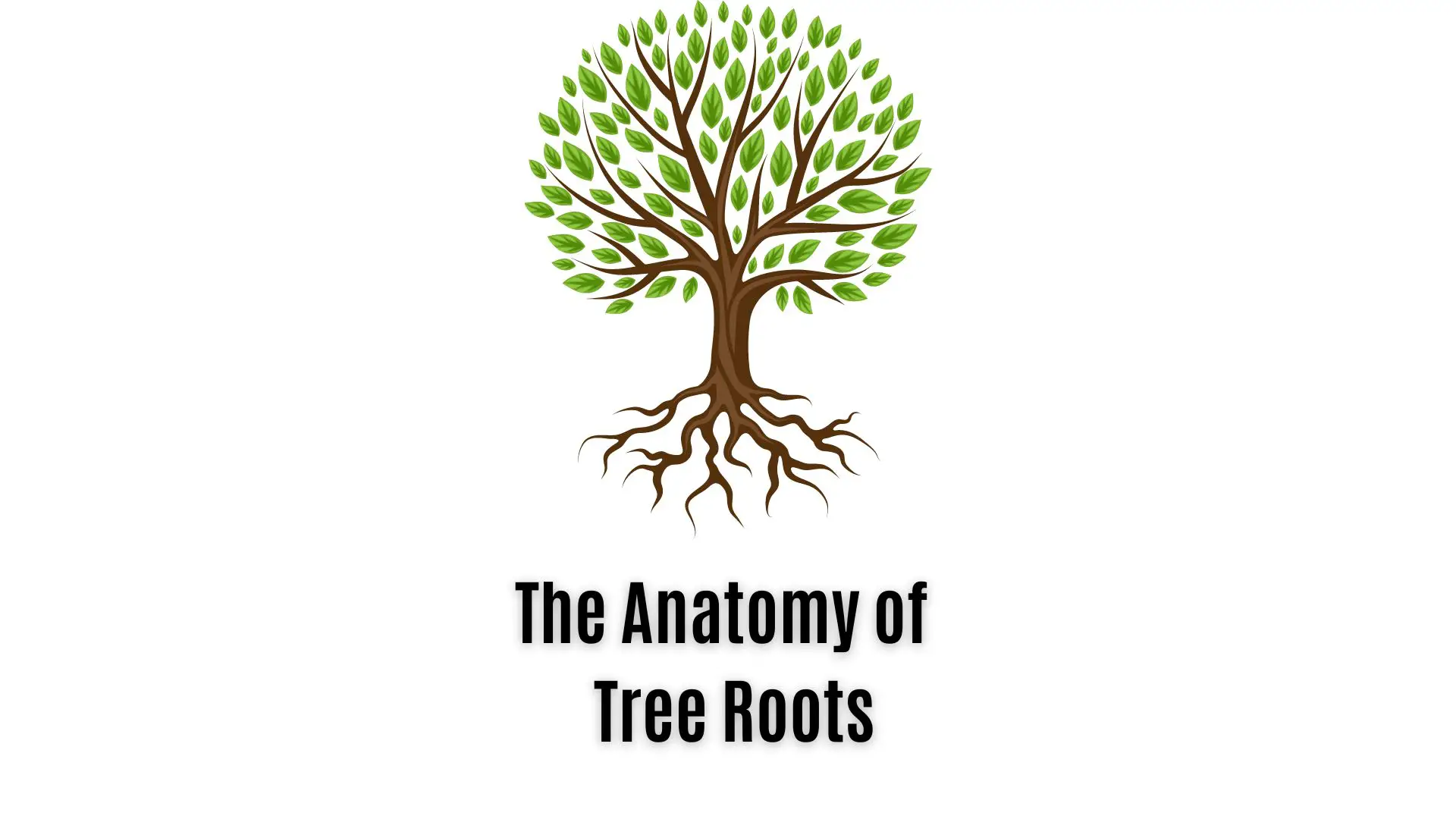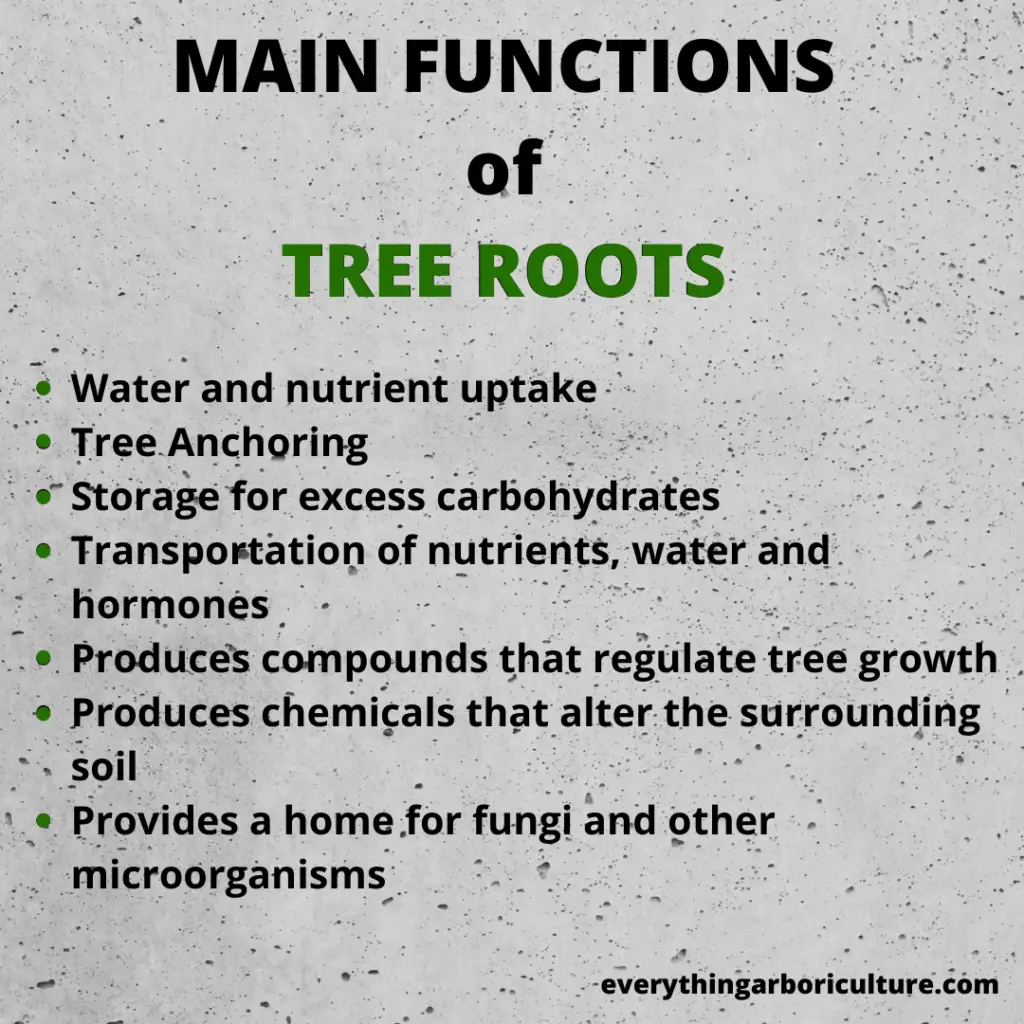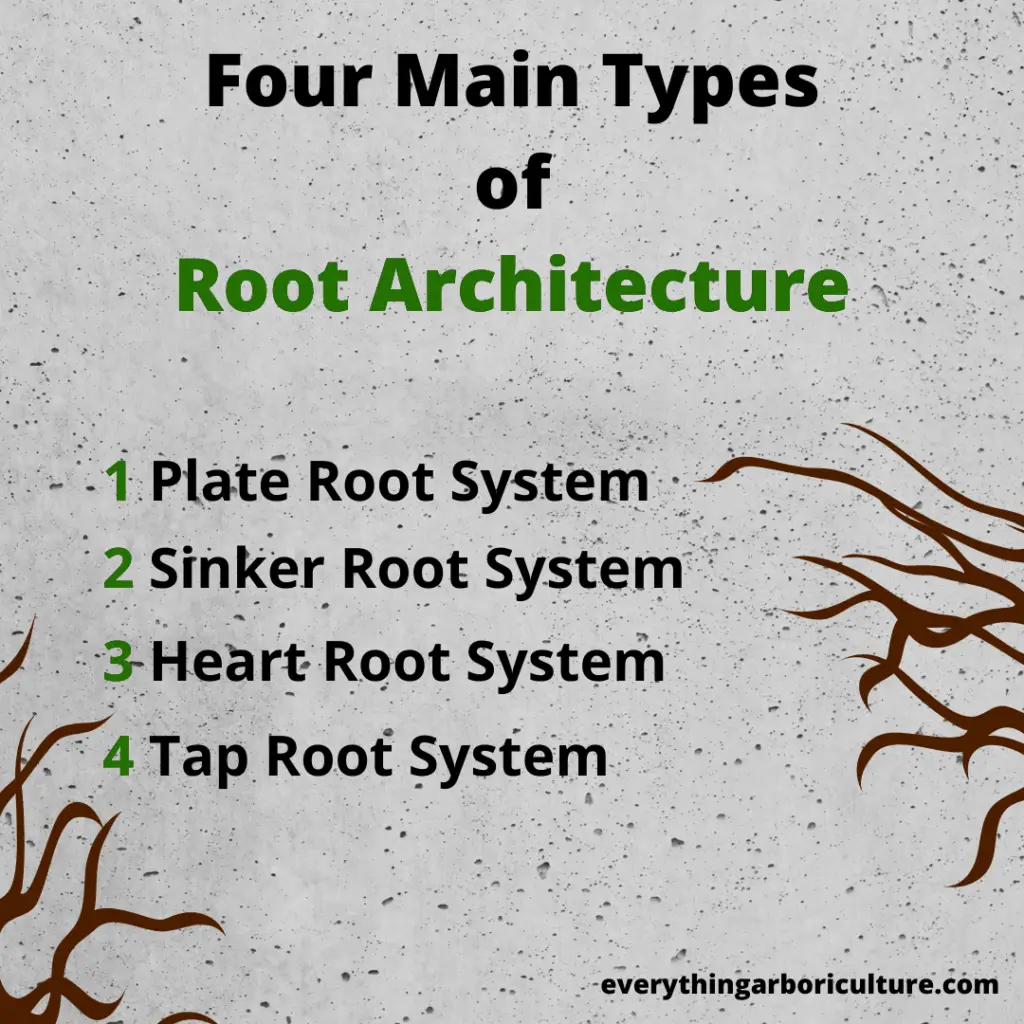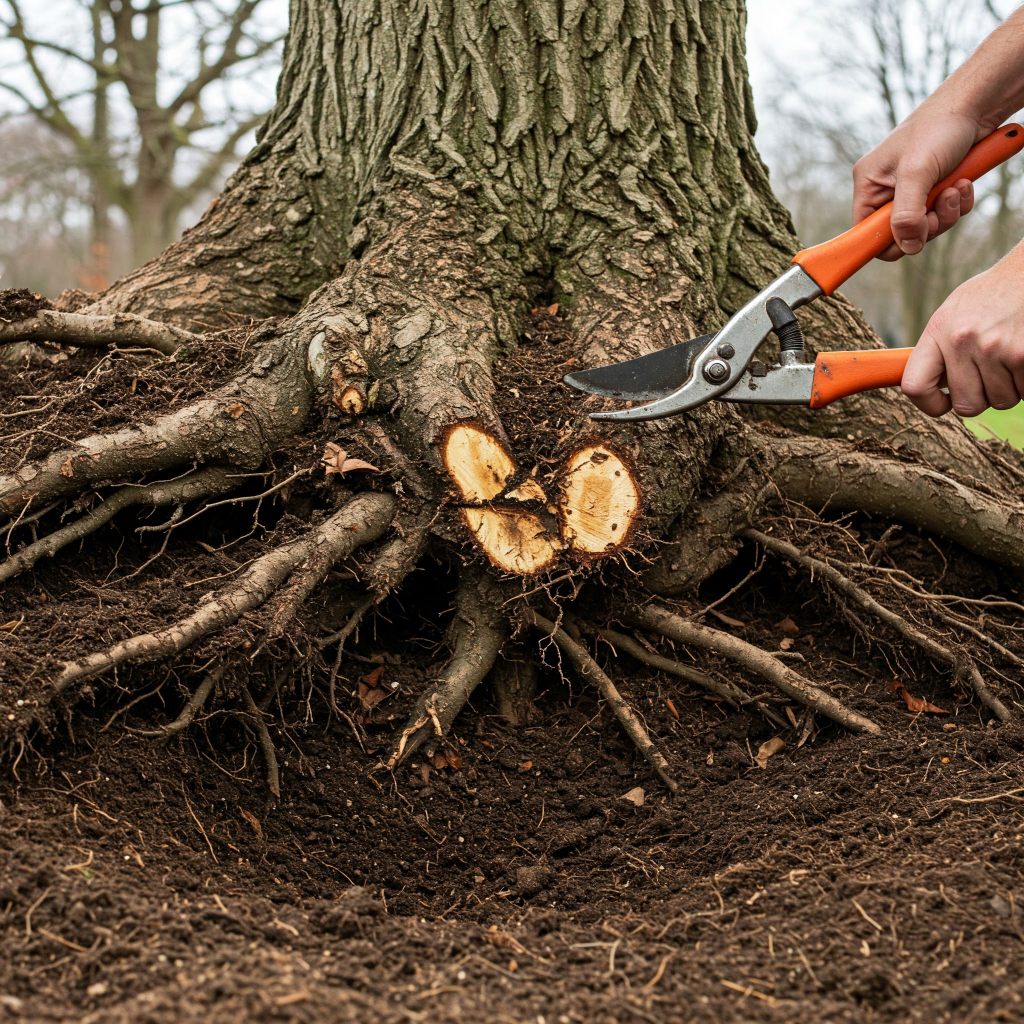
Tree roots are vital to the health and structure of a tree. Unfortunately, since tree roots are hidden, their importance gets overlooked. Arborists, or anyone interested in managing trees, should understand how tree roots work. Many illnesses and problems with trees begin at the roots.
In this article, I will take you through the ins and outs of tree roots, helping you to get a better understanding of them. I will cover:
- The Anatomy of a Tree Root
- Functions of Tree Roots
- Tree Root Growth
- Tree Root Pruning
I have been working with and studying trees for nearly seven years. I hope to impart some of my knowledge to you.

The Anatomy of a Tree Root
To understand tree roots, we must learn about their anatomy first. Anatomy simply means the structure of something.
All trees originate from seeds. When a seed germinates, it begins by sprouting a single root. This root is called the radicle, or first root. The radicle root will grow down into the soil, anchoring the seed.
Inside the radicle, near the tip, is the root apical meristem (RAM). The RAM contains cells needed to make new roots. Near the RAM is the quiescent center, which contains stem cells. These stem cells can help repair damaged root material.
Covering the RAM is the root cap. Think of the root cap like a helmet for the root. This helmet is hard, protecting the sensitive parts of the root. A strong root cap allows roots to push through soil in search of water and nutrients.
The skin of the root is called the epidermis. The epidermis layer protects the insides of the root, though this layer isn’t as strong as a root cap.
Along the epidermis are root hairs. Root hairs increase the surface area of roots, helping the roots explore more soil. With an increased surface area, roots can absorb more water and nutrients.
The epidermis covers the cortex. The cortex comprises loosely connected cells that allow different nutrients and substances to move through.
The next layer inside a root is the endodermis. The endodermis is the inner skin of the root, again protecting what’s inside from the outside world.
Think of the endodermis as a security guard working the door of a nightclub. Water needs to get to the inner layers of the root, but the water needs to go through the endodermis first. The endodermis will control how much water goes in.
The Casparian strip strengthens the endodermis. This Casparian strip comprises suberin, a corky-like substance. Suberin makes is difficult for anything to pass through.
Inside the endodermis is the pericycle which handles grow lateral roots. A bunch of pericycle cells will form the lateral root primordium (LRP). Eventually, the LRP will become a lateral root by bursting through the outer layers of the root into the soil.
Further into the centre of the root is where you will find the vascular system. The xylem and phloem make up this vascular system.
The xylem transports water throughout the tree. Whereas the phloem transports glucose.
Here’s an easy way to remember the difference between xylem and phloem:
The phloem transports glucose, which is food. Food begins with a ‘f’ and phloem begins with an ‘f’ sound. So, just remember the vascular system that transports food also starts with a ‘f’ sound. Then xylem is left over, which transports water.
And that’s my quick summary of the anatomy of a tree root. For a deeper look into each section of anatomy, check out this article. This article will explain things a little more.
Functions of Tree Roots
Most people associate tree roots with water absorption. While this is true, there are many other functions that tree roots perform.
Functions of tree roots include:
- Water and nutrient uptake
- Tree anchorage
- Storage for excess carbohydrates
- Transportation of nutrients, water and hormones throughout the tree
- Produces compounds that regulate tree growth
- Produces chemicals that alter the surrounding soil
- Provides a home for fungi and other microorganisms
Below, I will discuss each function in more detail.

Water and Nutrient Uptake
Trees absorb water and nutrients through their roots. The fine roots and their root hairs absorb the most. Whereas, large woody roots can only absorb small amounts of water and nutrients.
Water enters the roots through osmosis. Simply put, osmosis is the process of a liquid passing through the wall of a living cell. Through osmosis, the water needs to travel through the root’s cortex, past the endodermis and into the xylem.
There are three paths the water can take to get to the xylem:
- Symplastic pathway
- Apoplast pathway
- Transmembrane pathway
Explaining the finer details of each pathway is an article in itself. To read that article, click here.
Tree Anchorage
The architecture of a root system helps anchor a tree in the ground. This anchorage will prevent the tree from blowing over in strong winds. So, as an arborist, it’s important to understand tree anchorage and identify any root defects.
In root architecture, there are four general types of root systems. They are:
- Plate root systems
- Sinker root systems
- Heart root systems
- Taproot systems
Each of these systems will anchor the tree in different ways. However, each system shares one principle: the weight of the tree will help hold the tree in the soil.
Let’s look at each system more closely.
Plate Root System
In a plate root system, lateral tree roots grow out and interlock with each other, creating a stiff root plate. These roots are strong and resistant to bending, making the tree very stable.
Think of a plate root system like a wineglass. The wide base of a wine glass makes it stable. Now, imagine a wine glass with a tiny base and how unstable the glass would be.
Sinker Root System
Sinker root systems comprise many lateral roots. However, these lateral roots produce vertical sinker roots that grow straight down. The combination of lateral and vertical roots creates a root cage.
The root cage holds a significant amount of soil, adding to the weight of the tree. So, for the tree to topple, the force would have to overcome the weight of the tree, plus the weight of all the soil in the root cage.
Because sinker root systems are so heavy and stable, pruning of roots closer to the tree can be acceptable. But, please seek the advice of a qualified arborist before root pruning.
Heart Root System
Heart root systems comprise sinker and shallow lateral roots all bunched together. The roots being bunched together give the root system a root ball-like appearance.
Think of a heart root system like a shoulder joint. The strength of the soil combined with the weight of the tree holds the tree in place. So, when the soil strength changes, these trees are at risk of falling over. Wet weather can degrade soil strength.
Tap Root System
In tap root systems, the radicle develops a root that continues growing down, deep into the soil. Additionally, a few lateral roots develop.
Tap root systems work like a fence post. A fence post is much longer than it appears. The reason the post appears longer is that it is buried deep underground. Being buried so deep prevents movement in the wind. A tap root system works the same way.
To illustrate this point, take a pen or stick and place it in a small cup. Now, move the pen from side to side and notice how the bottom of the pen gets caught on the wall of the cup. Hitting the wall of the cup stops the pen from falling out of the cup when pushed over.
There are four main root system structures. They are plates, sinker, heart and tap. Each system will anchor the tree in a different way.

Storage for Excess Carbohydrates
Through photosynthesis, trees produce carbohydrates. The tree uses carbohydrates for a range of functions, including:
- Growing
- Wound healing via CODIT
- General maintenance
- Fighting pests and diseases
After these processes are done, there may be a surplus of carbohydrates. Rather than waste the excess carbohydrates, the tree will store them instead. The tree roots will act as a storage place for the excess carbohydrates.
Transportation of Nutrients, Water and Hormones Throughout the Tree
We now know that tree roots;
- Absorb water and nutrients
- Store excess carbohydrates
But tree roots also transport nutrients, water and even hormones throughout the rest of the tree. There are three different ways nutrients can move throughout a tree. They are:
- Root tip to shoot
- Shoot to the root tip
- Root tip to root tip
Tree roots assist in all three transport methods.
Produces Compounds That Regulate Tree Growth
This study confirms that tree roots help regulate the growth of the whole tree.
Roots will send signals to the shoots of the tree. These signals come as hormones and other substances, including:
- Abscisic acid
- Nitrate flux
- Cytokinin’s
Tree roots will sense the environment around them and regulate these signals accordingly. The signals can influence leaf expansion, stomatal behaviour and photosynthetic activity. All of which can promote whole tree growth.
Produces Chemicals That Alter the Surrounding Soil
Tree roots can also produce chemicals that alter the soil environment around them. Usually, roots will do this to their benefit.
These chemicals can change the PH of the soil. Nutrient availability will vary between different PH levels. Also, different species of trees will all prefer different soil PH levels.
So, tree roots may work to change the PH of the surrounding soil. The new PH levels may suit the tree, however, sometimes this change can be to the detriment of surrounding plants.
Provides a Home for Fungi and Other Microorganisms
It is well-known trees provide a habitat for birds, insects and small animals. But, did you know roots also provide homes for different organisms?
Some of these organisms include:
- Bacteria
- Yeasts
- Fungi
These organisms can be bad for a tree. However, many trees and fungi work together to form a symbiotic relationship. A symbiotic relationship is a mutually beneficial relationship.
Fungi will supply the tree with water and nutrients. In return, the tree will provide fungi with sugars and other substances.
Here are a few technical terms you may come across when learning about fungi and roots:
- Rhizosphere – The rhizosphere is a small area around a tree root. Tree roots directly affect this area. The rhizosphere is home to many types of organisms
- Mycorrhiza: This is the term used to describe the symbiotic relationship between roots and fungi.
Rhizosphere = Rye – zuhs – feer
Tree Root Growth
In this section, I will discuss all things relating to root growth. The topics covered are:
- How deep roots grow
- How far from the tree roots can grow
- When tree roots grow

How Deep Tree Roots Grow
The depth tree roots grow will vary by species and location. However, there are a few general outlines we can go by.
Most tree roots occur in the top one metre of soil. Roots occur in this portion of soil because of the high oxygen and mineral content. Also, water from rain is more accessible in this section of soil.
The deeper you go into the earth, the denser the soil gets. Many tree roots will struggle to push through dense soil, which is why soil compaction is an issue. Oxygen levels also get lower, the deeper into the earth you go.
From the book Applied Tree Biology:
For most trees, the top 50cm of soil hosts 80 – 90% of root biomass and 90 – 99% is in the top 1m.
Species that live in drier environments will have deeper roots. In drier environments, trees can’t rely on rain for water. So, these species will need to send their roots deep into the earth in search of water.
Generally, most tree roots are found in the top 1 metre of soil. However, trees in drought conditions will have much deeper roots because of the lack of water. Trees in drought conditions will need to search the earth for deep underground water reserves.
How Far Tree Roots Extend Out From a Tree
Again, the extent of tree roots will vary by species. But, there are some generalities that we can make.
As a general guide, most tree roots extend out 2 – 2.5 times the width of the crown. With tall, column-like trees, the root system extends out to the same height as the tree.
Research shows that most species have a maximums root extension of 20-30m. There are only a few outliers who can grow roots beyond this range. These genera are:
- Acacia
- Adansonia
- Juglans
- Metrosideros
- Populus
- Quercus
- Sequoiadendron
- Ulmus
Soil conditions play a role in the extension of tree roots. If a tree can not get enough water or nutrients within the normal growth range, the roots may need to extend out further. Likewise, heavily compacted soil may prevent roots from growing in certain areas.
When Tree Roots Grow
As a rough guide, tree roots start growing in early spring. Spring is the time of year when most trees put on a lot of new growth. So, roots will need to grow a bit earlier to assist with this fresh growth.
All this fresh growth makes spring the best time of the year to prune a tree.
However, trees are complicated, so there are many factors that determine when roots grow. Some of these factors include:
- Different parts of the root will grow at different times
- Different species will grow at different times
- Different trees within species will grow at different times
- Different sites will affect when roots grow
- Different years will affect when roots grow. For example, one year might experience much more rainfall that the previous year
Fine roots are important for a tree. These roots will absorb water and nutrients, which help the rest of the tree grow. So, if these fine roots don’t survive winter, the tree will need to focus on growing these roots before anything else. Once the tree has adequate fine roots, growth can resume for the rest of the tree.
To help our understanding of root growth, here are some things that promote root growth:
- Soil temperature between 5c and 20c
- Adequate moisture levels. Root growth will slow down as the soil gets drier. However, root growth will resume once water levels are increased
- Adequate oxygen levels. Soil oxygen levels need to be above 3% for roots to grow (the air has an oxygen level of around 21%)
Root Pruning
It’s possible to prune tree roots, however, there are many things to consider first. As we know, tree roots are vital to the health and structure of a tree.

Here are some reasons people prune tree roots:
- Prevent damage to property
- Transporting the tree
- Installing root barrier
- Installing new infrastructure (footpaths, roads, houses etc)
Before pruning the roots of a tree, you need to assess the tree’s general health. A healthy tree will have a better tolerance to root pruning. Sick trees may never recover from root pruning.
The Structural Root Zone (SRZ) is another thing to consider before pruning. The SRZ is the area of the root zone that contributes to the stability of a tree. Severing the wrong root in this zone could cause the tree to topple over.
For those of you who aren’t arborists, you will need to seek the advice of a certified arborist before pruning within the SRZ.
To calculate the SRZ, use the following formula:
SRZ radius = (D x 50) 0.42 x 0.64
Where D = diameter measured immediately above the root buttress.
Alternatively, the Bartlett Tree Experts recommend root pruning at a minimum distance of five-six times the diameter of the trunk.
Here are some further things to consider before pruning a tree root:
- Age of tree
- How many roots are being pruned
- Tree species
- Size of the root
- Soil type
- Site drainage
- Lean of tree
- Biosecurity
When you’re ready to prune a root, you will need to expose it. Be careful and take your time when exposing roots, as you don’t want to damage the root system any more than necessary.
Some methods of exposing roots include:
- Shovels
- High-pressure water
- Pneumatic air jets
- Trowel
When pruning, ensure you use sharp, clean tools. Sharp tools will ensure a clean cut that’s easily compartmentalized. And, clean tools minimize the risk of pathogens or diseases entering the root system. After pruning the tree root, fill the hole in with the same soil that you dug out.
It’s recommended that the tree’s health be monitored after root pruning. Trees are individuals, so each tree will respond differently to root pruning.
